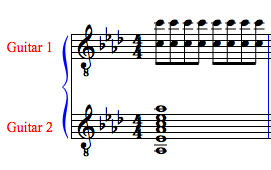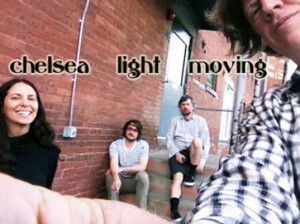I’ve been wanting to do a post like this for a long time. I think that periodically it will be fun to actually write about music theory stuff, considering that is what I am going to school for. I’m going to try to cover stuff that I find in rock tunes that I think is interesting, things that I would teach to my class. I’ll try to do this as clearly as possible. The main purpose, for me, is to maybe take some of the mystery out of music theory and also to help people possibly develop a little bit more of a critical ear.
The first song that I am going to use is “Arms Against Atrophy” from the first Titus Andronicus album “The Airing of Grievances” from 2009. Here’s the song:
Now, the first guitar we hear is playing two Cs an octave apart, and the 2nd guitar part comes in playing an A-flat major chord. So we can visualize it this way:
Based on the chord progression through the verse, an oscillation between A-flat major and F minor, we can say that this section of the song is pretty solidly in the key of A-flat major. Notice the key signature of 4 flats (B-flat, E-flat, A-flat and D-flat) and that neither an A-flat major chord or an F minor use any accidentals outside of that key signature, because both chords are diatonic, in other words – they belong to the key. The A-flat major chord is built on scale degree 1 while the F minor chord is built on scale degree 6, so in theory terms we would call these chords tonic and sub-mediant respectively. Basically the A-flat major chord is the most important, everything leads back to it.
Now, when I say that the chord is “built” on certain scale degrees what I mean is that the scale degree, of which there are 7, serves as the pitch that the rest of the notes in the chord are based on. Chords are formed by stacking thirds. For example the A-flat major chord would begin with A-flat and then a third above that (staying in the key) is C, and a diatonic third above that is E-flat.

Above we have the A-flat major scale. Scale degree 1 is A-flat, 2 is B-flat, 3 is C and so on all the way back up to A-flat. So if we stack thirds on top of each of these pitches we have something that looks like this:

From left to right we have tonic, supertonic, mediant, subdominant, dominant, submediant, and leading tone triads. The ones that we are going to focus on are the tonic and submediant. I won’t bother going into Roman Numeral analysis here to try to keep things simpler.
Looking at the diatonic triads we can see that the pitches in the A-flat major tonic triad are A-flat, C and E-flat; while the pitches in the submediant triad are F, A-flat and C. We can see that both of these chords have two pitches in common, the A-flat and the C.
Thinking back to that opening guitar line, the 1st guitar part that strums the C octaves in eighth notes. That C is a common pitch shared between both chords that appear in the verse, which allows the 1st guitar to keep those eighth notes constant throughout the verse. This is important to how the song is going to modulate.
When we say that a song modulates we are saying that the song is changing key. The most common modulation for a song that begins in a major key is to modulate to the dominant. One of the reasons that this is so common is because the keys are so close to each other, in a manner of speaking. The key signature for A-flat major, for example, is 4 flats, as we have seen above. The key signature for E-flat major (the dominant key) is 3 flats. The tonic chord of E-flat major can be taken directly from the key of A-flat major without changing anything, it remains E-flat, G, B-flat. We would say that these keys are closely related because they are next to each other on the circle of fifths.
Without going completely off course here, the circle of fifths is the way that we think of key relations. Basically this means hopping from one dominant to the next. For example A-flat, E-flat, B-flat, F, C, G, D, A, E, B, F#, C#, G#/A-flat …that is the complete circle of fifths beginning on the key that we are looking at here for this song. The further away from your home key, the more distant the relationship between the keys and the more chromatic alterations are necessary to maneuver between the two.
A modulation to a distantly related key, i.e. more than 2 steps on the circle of fifths, can be accomplished a few different ways. Again, I’m not going to go too far into it, because things get complicated pretty quick. One of the ways that you can, however, is through the use of a common pitch that exists in both of the keys. “Arms Against Atrophy” modulates to the key of C major in the bridge (2:20). Thee’s that C again.
Let’s compare the two scales, A-flat major and C major:


Note that the C major scale is lacking flats (or sharps, for that matter) in the key signature. This is because it is 4 steps away on the circle of fifths. Tonic of C major, C, is the same pitch as the mediant of A-flat major. Remember how A-flat, C, E-flat and F, A-flat, C made up the two chords of the verse, A-flat major and F minor respectively, with that C common between the two? Well the bridge here moves to a C major tonic: C, E, G. We know that it is a modulation and not just using the mediant triad because of the chord progression that follows that establishes the pitch C as the focus, or tonal center. Think of it like the center of gravity that all the pitches are drawn to. The chord progression in the bridge moves from tonic to dominant to subdominant and back to tonic again. We say that this progression establishes the tonic because it basically (simplifying again here) moves toward the dominant and returns to what is now being called tonic.
We would say, then, that “Arms Against Atrophy” by Titus Andronicus modulates from A-flat major to the distantly related key of C major through the common pitch of C. You can even hear the shift that happens, listen to the very beginning of the song. Hear those opening Cs, and then hear how they fit into the chords that guitar 2 introduces. Now go to 2:15 and listen to those very same Cs and hear how guitar two comes in now.
As a quick conclusion, you may be asking, “well the song returns to the verse after the bridge so…how do we get back to A-flat major tonic? I don’t hear the C-octaves again.” Well, first off I would say that it is true. Hey, you can’t keep doing the same thing over and over, right? The final chord of the bridge is F-major, or the subdominant in the key of C major and is made from the pitches F, A and C. Notice that this is only one pitch away from the F minor chord (F, A-flat, C) that was 50% of the verse. The last line of the bridge “…and she’s got the nail clippers at my throat,” (3:04-3:07) is where we are preparing to move back to A-flat major. The F major chord is used underneath “…and she’s got the nail clippers at my” and then they drop the A of the F major chord down a half step to A-flat on the word “throat” to create an F minor chord. That pitch, A-flat, then rings (3:07-3:17) alone until the verse picks up again with an A-flat major chord and we are up and running again, establishing the original tonic again. To be more technical this is referred to as a chromatic mediant relationship.
I hope that you were able to follow along here and that I could help you to understand the way that this song works and how music can work in general. This is only one tiny subject of many so I expect that I’ll be doing more of this in the future. Thanks for reading.










